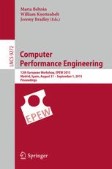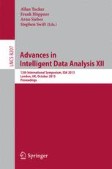Search
Search Results
-
Optimized multi-scale affine shape registration based on an unsupervised Bayesian classification
Here, we intend to introduce an efficient, robust curve alignment algorithm with respect to the group of special affine transformations of the plane...

-
A stacked deep learning approach to cyber-attacks detection in industrial systems: application to power system and gas pipeline systems
Presently, Supervisory Control and Data Acquisition (SCADA) systems are broadly adopted in remote monitoring large-scale production systems and...

-
A toolbox for the working scientist
Machine learning is possibly the core of artificial intelligence, as it is concerned with the design of algorithms capable of allowing machines to...
-
Advances in deep learning intrusion detection over encrypted data with privacy preservation: a systematic review
Many sensitive applications require that data remain confidential and undisclosed, even for intrusion detection objectives. For this purpose, the...

-
Extreme Learning Machines for Multiclass Classification: Refining Predictions with Gaussian Mixture Models
This paper presents an extension of the well-known Extreme Learning Machines (ELMs). The main goal is to provide probabilities as outputs for...
-
Canonical Form of Order-2 Non-stationary Markov Arrival Processes
Canonical forms of Markovian distributions and processes provide an efficient way of describing these structures by eliminating the redundancy of the...
-
Multiclass Learning from Multiple Uncertain Annotations
Annotating a dataset is one of the major bottlenecks in supervised learning tasks, as it can be expensive and time-consuming. Instead, with the...
-
A sparse kernel relevance model for automatic image annotation
In this paper, we introduce a new form of the continuous relevance model (CRM), dubbed the SKL-CRM, that adaptively selects the best performing...

-
Context Aware Sensing
In recent years, there have been considerable interests in context-aware sensing for pervasive computing. Context can be defined as “the...
-
Adaptive Neonate Brain Segmentation
Babies born prematurely are at increased risk of adverse neurodevelopmental outcomes. Recent advances suggest that measurement of brain volumes can...
-
Label Noise-Tolerant Hidden Markov Models for Segmentation: Application to ECGs
The performance of traditional classification models can adversely be impacted by the presence of label noise in training observations. The pioneer...
-
Automatic Speech-Based Classification of Gender, Age and Accent
This paper presents an automatic speech-based classification scheme to classify speaker characteristics. In the training phase, speech data are...
-
The Positive Effects of Negative Information: Extending One-Class Classification Models in Binary Proteomic Sequence Classification
Profile Hidden Markov Models (PHMMs) have been widely used as models for Multiple Sequence Alignments. By their nature, they are generative one-class...
-
A Probabilistic Model for LCS
Having conceptually defined the LCS model, it will now be embedded into a formal setting. The formal model is initially designed for a fixed model...
-
Automated Novelty Detection in Industrial Systems
Novelty detection is the identification of abnormal system behaviour, in which a model of normality is constructed, with deviations from the model...
-
A hierarchical multiple classifier learning algorithm
This paper addresses the classification problem for applications with extensive amounts of data and a large number of features. The learning system...
